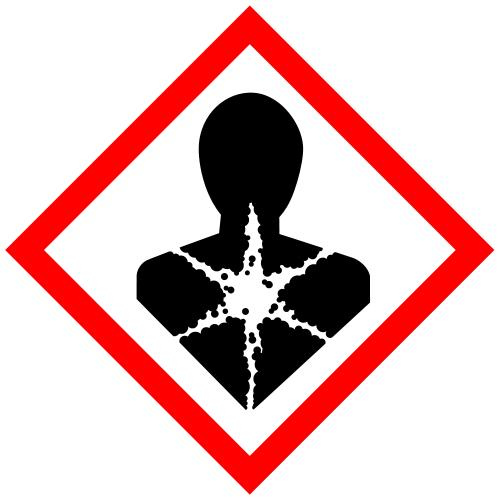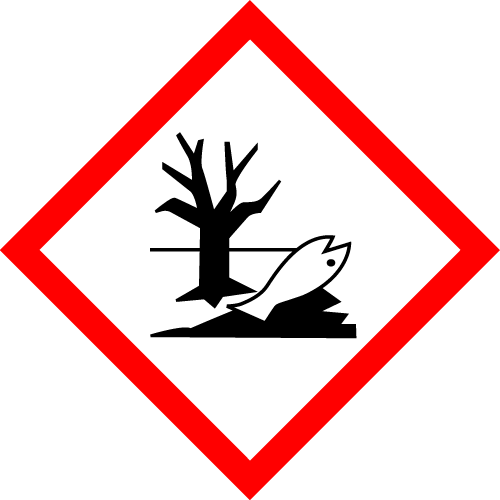Orange Molybdate Pigment
WARNING! CONTAINS LEAD AND CHROME
Orange molybdate is a brilliant orange pigment made by coprecipitation of lead chromate and lead molybdate often in the presence of lead sulfate and used in plastics, protective coatings and printing inks. Molybdate orange has been widely used in coatings and plastics for many decades during the 20th century because of its bright color and high hiding power. Its use in coatings and plastics today is currently restricted in several countries due to the lead and chrome content in its composition. Orange molybdate had a brief history of use by artists for several decades in the last century.
Pure tetragonal lead molybdate, which is colorless, forms orange to red tetragonal mixed-phase pigments with lead sulfochromate. The composition of red molybdate and orange molybdate pigments can be varied to give the required color properties.
Molybdate orange has been classified as Pigment Red 104 and number 77605 (Molybdate Orange/Red) in the Colour Index, a directory of pigments and dyes published by the UK Society of Dyers and Colourists and the American Association of Textile Chemists and Colorists.
Orange molybdate has not been rated for lightfastness by the ASTM, but independent studies have shown that this grade has good resistance to light, weathering, high temperatures and sulfur dioxide and can be used with all other pigments without alteration.
Water-Based Paint
In water-solved paints, orange molybdate is an opaque, highly staining, intense reddish orange pigment.
Oil Paint
In oil paint, orange molybdate is an opaque pigment with excellent tinting strength and exhibits very good resistance to light.
| Color Names | ||
| Common Names: | English: orange molybdate French: d'orange molybdate German: Orange Molybdate Italian: arancione di molibdato Russian: Оранжевый молибдат Spanish: anaranjado de molibdato | |
| Alternate Names: | Chrome vermilion; Lead chromate molybdate sulfate; Molybdate chrome orange; Molybdate orange; Molybdenum orange | |
Origin and History
Chrome was discovered by the French chemist Nicolas Louis Vauquelin in late 1790 in the mineral crocoite (lead sulfochromate). Vauquelin studied the different chrome compounds and found he could obtain a wide range of colors from greenish-yellow to orange shades.
A synthetic lead chromate (mainly chrome yellows) manufacturing process was published in 1809, although they were not mass produced until 1820 when the first large chrome deposits were discovered in North America.
The origin and development of molybdate red is well described by de Keijzer (1989): 'Molybdate red is a synthetic inorganic pigment, the first indication is from mineral origin when Schultz in 1863 noticed that the mineral Wulfenite (PbMoO4) had a strong red colour when it appeared with Crocoite (PbCrO4). Schultz carried out fusions with salts and noticed that 42% PbCrO4 dissolved in molten lead molybdate and after cooling a series of salts was set up with a dark red colour. Along the same lines Jaeger & Germs worked in 1921 by fusions at high temperatures. Mixed crystal pigments of lead chromate and lead molybdate were first described in August, 30 1930 by Lederle in a German patent (no. 22F.1.52.30) applied for by the I.G. Farbenindustrie A. G. Useful precipitations of mixed crystals of lead chromate and lead molybdate were later described in the patents of Lederle and Grimm (German patent 574,379, April 12, 1933, and 574,380, April 13 1933; see also U.S. patent 1,926,447, September 12, 1933). The second American patent of Lederle (1936) described a process of producing red pigments by precipitating mixed crystals of normal lead chromate, sulfate and molybdate, using strongly acid solution. The commercial pigment appeared on the market in 1934�35 in the United States. The Belgian patent by Linz (1937) described the production of orange and red mixed crystals of lead chromate, lead molybdate and lead carbonate or phosphate [�] Much research has been carried out to eliminate imperfections: the instability of the crystal structure and the lightfastness. Two parents are of importance: [one of 1944 by] Botti where he describes the lightfastness increased by depositing on the pigment particles a film which is a combination of aluminum hydroxide, titanium oxide and rare earth oxide. The second patent is by Huckle and Polzer (1943). They discovered that by reacting trivalent antimony compounds with lead chromate pigments the resistance of such pigments to colour deterioration by action of light and weather is materially increased.'
Although molybdenum orange went into production soon after 1935 for use in printing inks and paints, it is not known that it was used in artists' paints until later. According to Susan Lake, it was found in combination with other pigments in Willem de Kooning's 1965 painting Woman. (Lake, 2010)
Permanence and Compatibility
The fastness properties of orange molybdate and red molybdate pigments are comparable with those of the chrome yellows. As with the chrome yellows, the pigment particles can be coated with metal oxides, metal phosphates, silicates, etc., to give stabilized pigments with high color brilliance and good fastness properties, as well as highly stabilized grades with very good resistance to light, weathering, sulfur dioxide, and temperature and with a very low content of acid-soluble lead. (Buxbaum, 2008)
Rublev Colours Orange Molybdate is a silicate-coated grade with very good lightfastness.
Combinations with organic red and yellow pigments give a considerable extended color range. Such combinations have very good stability properties because the lightfastness and weather resistance of many organic red pigments are not adversely affected by molybdate pigments. For example, Colour Index Pigment Red 3 (Toluidine red) is often used in conjunction with molybdate red.
Oil Absorption and Grinding
Orange molybdate absorbs a moderate amount of oil; about 27 grams of linseed oil per 100 grams of pigment to make a paste. Stabilized grades of orange molybdate have a low binder demand (low oil absorption); good dispersibility, hiding power, and tinting strength; and are very high lightfastness and weather resistance.
Toxicity
Orange molybdate contains lead and chrome is considered to chronic toxic, and hence care should be used in handling the dry powder pigment to avoid inhaling the dust.
References
Buxbaum (2008) Buxbaum, Gunter Industrial Inorganic Pigments 2nd Edition, John Wiley & Sons (2008) 119�120
Eastaugh (2008) Eastaugh, Nicholas; Walsh, Valentine; Chaplin, Tracey; Siddall, Ruth Pigment Compendium: A Dictionary and Optical Microscopy of Historic Pigments Routledge (2008) 271
Keijzer (1989) Keijzer, M. de 'The colorful twentieth century' Modern Art: The restoration and techniques of modern paper and paints UKIC, London (1989) 13�20
K�hn & Curran (1986) K�hn, H.; Curran, M. 'Chrome Yellow and Other Chromate Pigments' Artists' Pigments, A Handbook of their History and Characteristic 1 Feller, R.L. (ed.) National Gallery of Art, Washington and Cambridge University Press, Cambridge (1986) 187�218
Lake (2010) Lake, Susan F.; de Kooning, Willem; Schilling, Michael Roy Willem De Kooning: The Artist�s Materials Getty Publications (2010) 84

Rublev Colours Pigment: Orange Molybdate in oil
| Pigment Information | |
| Color: | Orange |
| Colour Index: | Pigment Red 104 (Colour Index No. 77629) |
| Chemical Name: | Lead Chromate, Lead Molybdate, Lead Sulfate |
| Chemical Formula: | PbCrO4.PbMoO4.PbSO4 |
| CAS: | 12656-85-8 |
| ASTM Lightfastness Rating | |
| Acrylic: | Not rated |
| Oil: | Not rated |
| Watercolor: | Not rated |
| Properties | |
| Specific Gravity: | 4.3 |
| Density (g/cm3: | 5.4-6.3 |
| Bulking Value (ml/100g): | 250-300 |
| Sieve Residue, Maximum (325 mesh): | 0.5% |
| pH: | 6.0-8.0 |
| Lightfastness (1-8): | 7 |
| Acid Resistance (1-5): | 5 |
| Alkali Resistance (1-5): | 5 |
| Refractive Index: | 2.3-2.65 |
| Oil Absorption: | 27 g oil/100 g pigment |
| SKU | 447-21 |
|---|---|
| Brand | Rublev Colours |
| Vendor | Natural Pigments |
| Processing Time | Usually ships the next business day. |
| Color | Orange |
| Pigment Type | Inorganic, Synthetic |
DANGER! CONTAINS LEAD. HARMFUL IF SWALLOWED. Avoid ingestion and skin contact. Wear protective clothing and gloves to prevent contact with skin. Never use near children or pets. Read the MSDS for all cautionary statements. Conforms to ASTM D 4236.
DANGER
CONTAINS LEAD / CONTIENT DU PLOMB
DO NOT APPLY TO SURFACES ACCESSIBLE TO CHILDREN OR PREGNANT WOMEN.
NE PAS APPLIQUER SUR UNE SURFACE ACCESSIBLE AUX ENFANTS OU AUX FEMMES ENCEINTES.
Must be used exclusively as material for the purposes of arts, crafts or hobbies, not for use by children. Utiliser uniquement aux fins suivantes comme matériaux pour les besoins d’art, d’artisanat ou passe-temps, pas pour une utilisation par les enfants.
Hazard Pictograms
 |  |  |
| GHS07: Exclamation Mark | GHS08-2: Health Hazard | GHS09: Environment |
Signal Word: Danger
Hazard Designation
H302 Harmful if swallowed.
H332 Harmful if inhaled.
H360 May damage fertility or the unborn child.
H373 May cause damage to organs through prolonged or repeated exposure.
H410 Very toxic to aquatic life with long lasting effects.
Safety Designation
P260 Do not breathe dust/fume/gas/mist/vapors/spray.
P261 Avoid breathing dust/ fume/ gas/ mist/ vapors/ spray.
P280 Wear protective gloves/ clothing/ eye/ face protection.
P281 Use personal protective equipment as required.
P405 Store locked up.
P501 Dispose of contents/ container according to regional, national and international regulations.
![]() WARNING: This product can expose you to chemicals including lead and chromium-hexavalent, which is known to the State of California to cause cancer and birth defects or other reproductive harm. For more information go to www.P65Warnings.ca.gov.
WARNING: This product can expose you to chemicals including lead and chromium-hexavalent, which is known to the State of California to cause cancer and birth defects or other reproductive harm. For more information go to www.P65Warnings.ca.gov.



